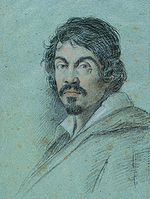- Death of the Virgin (Caravaggio)
-
Death of the Virgin 
Artist Caravaggio Year 1604-1606 Type Oil on canvas Dimensions 369 cm × 245 cm (145 in × 96 in) Location Louvre, Paris The Death of the Virgin (1606) is a painting completed by the Italian Baroque master Caravaggio. It is a near contemporary with the Madonna with Saint Anne now at the Galleria Borghese. It was commissioned by Laerzio Alberti, a papal lawyer, for his chapel in the Carmelite church of Santa Maria della Scala in Trastevere, Rome.
The depiction of the Death of the Virgin caused a contemporary stir, and was rejected as unfit by the parish. It was acquired by the Gonzaga family in Mantua and subsequently, upon the recommendation by Peter Paul Rubens, who praised it as one of Caravaggio's best works, the painting was bought by Vincenzo Gonzaga, Duke of Mantua, whose collection had later to be sold to Charles I of England. After his execution the English Commonwealth put his collection up for sale, and the painting was bought for the French Royal Collection, which after the French Revolution became the property of the state. Today it hangs in the Louvre. Prior to leaving Rome, it was exposed at the Academy of Painters for under two weeks, however, by then, Caravaggio had fled Rome, never to publicly return. During one of his frequent brawls in Rome, the mercurial and impulsive Caravaggio killed a man, Ranuccio Tomassoni, during a sword fight after a tennis game.
The painting recalls the Entombment in the Vatican in scope, sobriety, and the photographic naturalism. The figures are nearly life-sized. Surrounding the Virgin are overcome Mary Magdalen and apostles. Others shuffle in behind them. He expresses the greater grief of the former not by a more emotive face, but by hiding their faces. Caravaggio, master of stark and dark canvases, is not interested in a mannerist exercise that captures a range of emotions. In some ways this is a silent grief, this is no wake for wailers. The sobbing occurs in faceless emotional silence. The holiness of the Virgin is discerned by her thread-like halo. A large red cloth looms in the upper portion of the canvas; a common motif in deposition painting.
This painting was completed at a time when the dogma of the Assumption of Mary was not yet formally enunciated ex cathedra by the pope, but had been gaining ground for some centuries. When the assumption body and soul was finally declared dogma in 1950, the doctrinal statement carefully avoided declaring whether this was before or after Mary's death in the normal way; the New Testament does not cover the matter at all. How she passed from this world is and was therefore not a matter of Catholic dogma, although by the 17th century, the conventional belief among Catholics was that she was assumed alive, as shown in the great majority of contemporary paintings of the subject. Some envisioned a post-death Dormition as a moment when God resurrected her non-putrid body to heaven. By then most believed that she felt no pain or disease, and that she was assumed in healthy if aged body and soul prior to "death". Caravaggio's painting is the last major Catholic work of art in which Mary is clearly dead. Her feet are swollen, and no cloud of cherubs ferries her heavenward as depicted less than a decade before by Annibale Carracci (see Assumption of the Virgin (Carracci)) for Cerasi Chapel. He does not depict an assumption but her death, arm drooping to the earth. The figure, like that in nearly all Renaissance and Baroque Assumptions, looks much younger than a woman some 50 or more years old;[1] medieval depictions of the death were often more realistic in this respect. Contemporaries accused Caravaggio of modelling a mistress/prostitute as the Virgin.
See also
Other Madonnas by Caravaggio:
- Madonna of Loreto
- Madonna and Child with St. Anne (Dei Palafrenieri)
- Madonna of the Rosary
References
Sources
- Hibbard, Howard (1983). Caravaggio. Harper and Rowe.
Categories:- 1600s paintings
- Caravaggio paintings
- Paintings of the Louvre
- Paintings of the Virgin Mary
- Paintings depicting death
Wikimedia Foundation. 2010.

